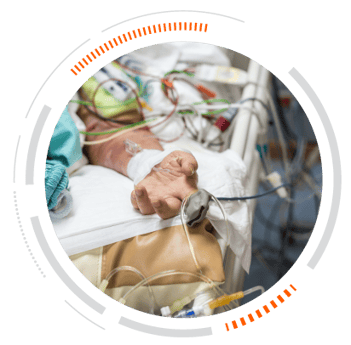MedLite ID: An Innovation Reducing Infusion Confusion
While America’s healthcare system is no stranger to criticism and you likely already know about its...

In the ICU, many patients receive multiple infusions at a time. This makes it difficult to differentiate each line, as healthcare professionals must identify and follow the tubing, pump, and access port to make an infusion change.
Considering this complicated setup, not only can delays occur, but patients may also be severely harmed and, in some cases, killed.
Infusion confusion, in plain terms, is a tangled mess of IV lines. A patient can have five-seven lines in at a time, though the number can be upwards of 15 in certain situations. The lines become easily entwined, reflecting the notion of “spaghetti syndrome.” Having so many drips can be very difficult to manage for healthcare professionals. If they are unfamiliar with the patient, it can take up to five minutes or so to trace and assure the IV line is an infusion line and not a drip.
 IV tubing tends to look similar — considering they all contain a clear or white fluid — and IV lines do not line up with their associated pumps. These challenges make line tracing increasingly exigent.
IV tubing tends to look similar — considering they all contain a clear or white fluid — and IV lines do not line up with their associated pumps. These challenges make line tracing increasingly exigent.
This is especially true when it comes to administering intermittent medication. Some medications, like those for blood pressure and sedatives, need to titrate up and down throughout the day. Depending on the half-life and necessary ccs per minute/hour of the medication, nurses are required to change infusions several times per shift.
This is when having a clearly identified infusion line is critical. If a patient codes (i.e. their blood pressure gets dangerously low or their heart stops), you have a team of people rush into the room. When minutes matter and you’re in this high-stress situation, infusion confusion is very likely to occur. Knowing which line is the safe line is imperative when having to inject a life-saving drug.
Currently, many nurses label their tubes with medical tape to help them identify the correct line. They also use special clips to align the tubes and keep them together for less tangle. While these efforts do make some improvements to the IV setup, it is still not ideal.
For instance, a lab study conducted by MedLite explored the existence of pathogens in medical tape. The study concluded that 80% of the used rolls of medical tape tested were positive for pathogens — and 16 of the 36 bacteria and fungus found were pathogenic.
This method of infusion identification can actually lead to a healthcare-acquired infection (HAI). HAIs cost U.S. hospitals $96-$147 billion annually in direct and indirect costs, with central-line-associated bloodstream infections adding the most cost at $45,814 per case.
A better solution is needed to help clearly identify the main infusion line and avoid the costs that come with an error.
When managing multiple IV infusions, nurses must be able to quickly identify the contents, location, and infusion pump parameters for each line. Misidentifying an infusion — or not identifying a line quickly enough — can have serious consequences.
In a MedLite study, 60% of infusions contained one or more errors. IV labeling and tubing accounted for approximately 65% of the mistakes — the most frequent being attributed to infusion confusion. In fact, 61% of the most serious and life-threatening potential ADEs are IV drug-related.

Delivery of a single medication dose to an individual patient requires the correct execution of 80 to 200 individual steps … With that in mind, each added IV line increases the likelihood of an ADE by 3%. Beyond the effects on patients and providers, medical errors can have a significant impact on organizations (and the healthcare market as a whole). For example, infusion-related errors are estimated to add $2 billion annually to U.S. healthcare costs.
In the event that a severe or fatal infusion-related error occurs, the patient will become a victim. However, many don’t realize there is a second victim in this situation: the healthcare professional that was involved.
The second victim will often experience a variety of emotional reactions, including shame, embarrassment, and guilt. Many people develop clinical depression or Post-Traumatic Stress Disorder (PTSD) as a result of the incident.
The personal and professional effects of the adverse event are usually long-lasting. While most of the emotional and behavioral symptoms go away over time, the painful memory of the incident stays with the second victim. Some people lose their jobs or consider changing career paths. Overall, there is a significant need for support from peers, professionals, and organizations.
If an error occurs, “The optimal outcome is you learn from experience and it never happens again” (Bruce Cusson, RN). However, the feelings of guilt and shame still linger. Sadly, the kind of unconditional sympathy and support that the second victim needs are rarely forthcoming.
Healthcare professionals with COVID-19 patients are particularly at risk for spaghetti syndrome. Many COVID-19 patients and those in the ICU require having several drips at the same time.
When dealing with so many lines, nurses have to spend more time tracing which means spending more time in the room. Not being able to identify the desired line leads to a longer duration of exposure to the disease. (In efforts to combat this, many nurses have started to put infusion pumps outside the room instead of at the patient’s bedside. This way, they can titrate medications without even having to open the door.) Being able to quickly determine the safe infusion line will save time and help reduce COVID-19 exposure on a day-to-day basis.
When there are multiple IVs at a patient’s bedside, it is very difficult for healthcare professionals to trace the correct infusion line. There is only one line — the safe line. When a life-saving drug needs to be administered, every minute matters. No time can be wasted on tracing the safe line … and if the wrong one is used, the consequences can be fatal.
To avoid this, having an effective solution to infusion confusion is crucial. Healthcare professionals must be able to clearly identify the safe line and, in turn, save lives.

While America’s healthcare system is no stranger to criticism and you likely already know about its...

New Published Study Shows MedLite ID as Faster and Simpler Solution to Primary Medication Infusion...
Leave a Comment